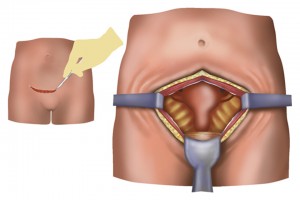There are a number of infertility treatments available. One of the treatments offered to women with blocked fallopian tubes is tubal surgery, also called tuboplasty. One of the goals of this procedure is to remove adhesions – scars that form when the body heals from surgery, infection, inflammation, or trauma.
What happens during tubal surgery?
Tubal surgery is performed either via laparoscopy or laparotomy. Laparoscopy is a minimally invasive surgery in which a very small camera attached to a thin telescope is inserted through a small incision below the belly button. The procedure may also be performed via laparotomy or open surgery. During a laparotomy, an incision is made usually between the belly button and the pubic bone.
A blocked tube can be cut and the adhesions cut or burned. The surgeon may also attempt to separate the fimbriae — the finger-like structures that grasp the egg when it leaves the ovary and help transport it. Adhesions can bind these delicate structures together, resulting in a condition called clubbed fimbriae. As a result, the fimbriae lose their ability to grasp the egg.
Success rates
Performing surgery on structures as tiny and delicate as the fallopian tubes can be challenging. Following surgery, adhesions tend to form to help the body heal. Thus, most surgeons feel that surgery to open blocked fallopian tubes provides a brief window during which to conceive before adhesions form and re-block the tubes.
The journal Human Reproduction reported that only 19 percent of blocked fallopian tubes remained open six months after a minimally invasive surgery to clear the tubes.
Schedule a phone consultation with an expert therapist to learn more about opening blocked fallopian tubes naturally.
Risks
The biggest risk associated with tubal surgery is tubal (ectopic) pregnancy. A tubal pregnancy is more likely in women who have had tubal surgery or tubal disease. In an ectopic pregnancy, the fertilized egg remains in the fallopian tube and begins to grow there instead of traveling to the uterus. The fallopian tube is not big enough to hold a baby and will eventually burst if the pregnancy continues. Common symptoms include irregular bleeding and lower abdominal pain.
Additional risks include damage to other organs and reaction to anesthesia.
A natural alternative
Therapists certified in the Wurn Technique® use their hands to detach the adhesions that block fallopian tubes. They do so using manual therapy protocols. In contrast with a number of other infertility treatments, it does not involve drugs or surgery.
A 2008 study published in the peer-reviewed medical journal Alternative Therapies in Health and Medicine and summarized in gynecologists’ professional journal Contemporary Ob/Gyn, showed that the Wurn Technique achieved a 61% success rate opening blocked fallopian tubes in women with totally blocked tubes. Most of these women went on to conceive naturally and a number have had subsequent pregnancies and births with no further therapy.
References
- http://www.asrm.org/Conceiving_After_Tubal_Surgery/
- http://www.womenssurgerygroup.com/treatments/comparelaparo.asp
- Treating-Fallopian-Tube-Occlusion
- Contemporary-obgyn
Related Content:
Diet
Ectopic Pregnancy
Sexual Dysfunction
General Info
- Book Chapters: Overcome Infertility and Pain, Naturally
- How to Treat Infertility Naturally
- Everything about the Best Natural Infertility Treatments
- Fertility Treatment – The Natural Way
- Infertility Risk Factors
- What Causes Infertility in Women? (Infographic)
- [Infographic] Common Risk Factors for Infertility
- How Does Tubal Surgery Compare to Other Infertility Treatments?
- Published Pregnancy Rates With and Without Clear Passage®
- Budgets and Numbers and Bills, Oh My! – Paying for Infertility Treatment
- English Surrogacy
- Guide Through Infertility: From Diagnosis to Treatment
- Spirituality Can Help Women with Premature Ovarian Failure
- For Healthcare Providers: Women’s Health Issues and Female Infertility
Infertility: Adhesions | Blocked Fallopian Tubes | Diet | Ectopic Pregnancy | Endometriosis | FSH | Hydrosalpinx | Hysterosalpingography | Female Infertility | IVF Conditions | Ovarian Failure | PCOS | Secondary Infertility | Unexplained Fertility
























